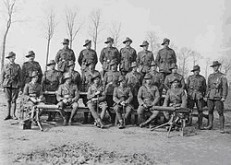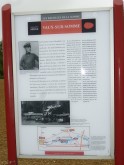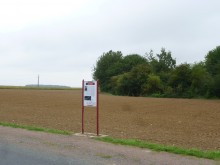POPKIN Cedric Bassett
-
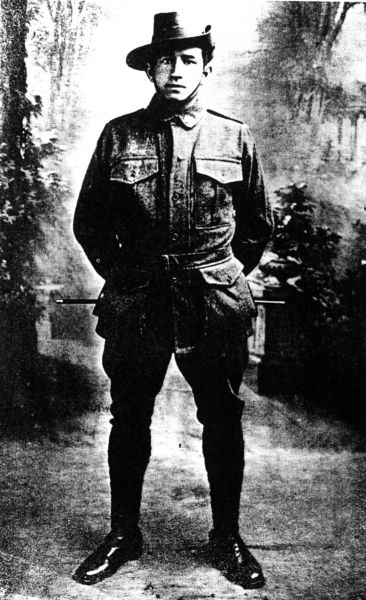
- 424
- Sergeant
- 24th Machine Gun Company
- Palmwoods
- Yes
- 1891
- Sydney, New South Wales
- 6 May 1916
-
Cedric Bassett Popkin, Service No 424, from Palmwoods, Queensland, is now considered the person most likely to have killed German flying ace Manfred von Richthofen, also known as the "Red Baron" on 21 April 1918. Popkin was an anti-aircraft machine gunner in the 24th Machine Gun Company, part of the Australian 4th Division, stationed in the Somme Valley, France.
This article is in three parts, depicting the personal and military histories of Cedric Popkin, and the story of the shooting down of the Red Baron.
Personal
Following their marriage in Queensland and birth of their first daughter Gladys Lilian, Dan William Bassett Popkin and his wife Lilian moved to St Leonards in Sydney where a daughter Sophia Edith was born in 1887 quickly followed by Marjory in 1888 . On 20 June 1890 Cedric Bassett Popkin was born , followed by Dorothy in 1892 (in Queanbeyan NSW) and another boy Roland G in 1894 at Marrickville in Sydney.
By 1895 the Sands Directory gives Dan's address as the "Derby Hotel" in Regent Street, Sydney and in 1896 he is listed at Terminus Street, Sydney. Within a few years the family had moved to Grafton in the northern rivers district of NSW. There Lilian Popkin, Cedric's mother, died in 1902 when Cedric was 12 years old .
Edith, 15, and Marjory, 14, took over the caring of the younger children as Dan travelled with his work as an insurance agent. With his father away most of the time, controlling young Cedric was not an easy task and he was soon in trouble with the law. Entrance books for the "Sabraon", a ship moored in Sydney Harbour serving as a boy's industrial school , reveal that 13 year old Cedric was arrested for "stealing from the Grafton Public School one cadet cap". A student at the same school, Cedric was reported as having a "bad" character who had been before the Bench of Magistrates previously. The police report stated "he keeps company with bad companions and often sleeps out at night".
His troubled youth behind him, by 1908 Cedric was working as a builder at Mullumbimby in northern NSW. Five years later Cedric was living alone at Irving Street, Torwood in Brisbane and working as a carpenter when he met and married Nellie Ellen Bull on 10 March 1913. The young couple moved to South Murwillumbah where Cedric found work as a tobacconist. Cedric and Nellie had two sons, Roland and Michael, and the family moved to Palmwoods in Queensland before the outbreak of WW1.
On 25 March 1916 Cedric's father Dan died at Lismore NSW and his younger brother Roland, then living in Wales, enlisted in the British Army. An older sister Gladys Lilian also served in WW1, as an Australian army nurse. She served in Greece and returned to Australia in 1918. Cedric enlisted in the AIF on 6 May 1916 and did not see his family again for three long hard years. Nellie remained with the children at Palmwoods until Cedric returned, quite a different man from the one who left.
After the war Cedric and Nellie returned south to NSW and by 1930 Cedric had taken up the position of Postmaster at Tyalgum, near Murwillumbah. They remained at Tyalgum for about ten years and then moved further north to run the post office at Cudgen. He then returned to his previous trade of carpentry, and aged 59 Cedric and Nellie were living Fingal Head. Cedric's sister Edith Sophia lived with them for a short time around 1958 and they remained at Fingal Head until at least 1963.
Nellie Popkin (nee Bull) died in 1965 at Murwillumbah. Cedric Popkin died in 1968 at Tweed Heads NSW.
Military
Just before his 26th birthday, on 6 May 1916, Cedric Bassett Popkin travelled to Brisbane to enlist in the AIF. Cedric and his wife Nellie were then living with their two children at Palmwoods in Queensland and he was working as a carpenter. Cedric's enlistment papers describe him as 5ft 6 ½ in tall, 150 lbs, brown eyes and black hair.
Cedric, Service No 424, was originally assigned to the 6th Machine Gun Reinforcements as a private on 20 June, then to the 7th Machine Gun Company on 4 August 1916 when he embarked in Melbourne on the Port Lincoln. On arriving at Sierra Leone, Cedric and his company were transferred to the Ulysses which carried the troops to England.
Whilst in training camp at Perham Downs on Salisbury Plains, Cedric was reprimanded for insulting language to a NCO, which turned out to be his one and only military offence.
On 9 August 1917, Private Popkin was appointed Lance Corporal with 17th Machine Gun Company at Parkhouse Training Camp. On 30 August Cedric was assigned to the 24th Machine Gun Company as Acting Corporal, then Corporal, and shipped out to France on 7 September with his unit. Cedric's company was based at Camiers in France, the base depot for the Machine Gun Corps where he attended training school.
On 2 March 1918 Cedric was promoted to Training Sergeant, shortly before the company photograph was taken . By 7 April, when his company commander Sgt Phee was declared missing in action, Cedric was promoted to Sergeant.
On 21 April 1918 whilst at his post as a gunner with his Vickers Machine Gun, at Corbie in the Somme Valley, Sergeant Cedric Popkin encountered the Red Baron. The story is told in the following section.
Cedric received a severe gunshot wound to his right leg on 19 June and was moved to 4th Field Ambulance. The next day Cedric was at the 47th Casualty Clearing Station before being moved to the 3rd Australian General Hospital. Despite some rest and treatment, Cedric's wound was not healing so he was transported to England on 4 July on HSS Andrew. On admission to the Queen Victoria Hospital at Netley, Cedric's right leg was amputated. He remained in hospital for two months before being discharged to the 2nd Auxiliary Hospital at Southall. Cedric wasn't discharged from hospital until 6 January 1919 when he embarked on HT Kanowna for the voyage back to Australia.
Sgt Cedric Popkin 424 and the Red Baron
At about 10.35am on 21 April, Baron von Richthofen, flying his red Fokker DR-1, engaged Sopwith Camels from 209 Squadron, RAF. He pursued a Camel piloted by a Canadian, Lieutenant Wilfrid May. In turn, the Baron was chased by another Canadian pilot, Captain Roy Brown. The three planes flew over Morlancourt Ridge, in the 4th Division's sector, and Popkin "using a Vickers machine gun" and other Australian machine gunners and riflemen also fired at Richthofen. The Baron was hit by a 0.303 calibre bullet which passed diagonally from right to left through his chest. He then made a hasty but controlled landing, in a field on a hill near the Bray-Corbie road, just north of Vaux-sur-Somme. His Fokker was not damaged by the landing. One witness, Gunner George Ridgway, stated that when he and other Australian soldiers reached the plane, Richthofen was still alive but died moments later. Another eye witness, Sergeant Ted Smout, reported that Richthofen's last word was "kaput" ("finished") immediately before he died. Richthofen had allied plane kills to his credit and was only 25 when he died. Despite his enemy status, von Richthofen was so highly respected that the Allies buried him with full military honors alongside their own dead.
Von Richtofen's success as a flying ace earned him the nicknames der rote Kampfflieger (the Red Battle-Flyer) by the Germans, petit rouge (the little Red) or le Diable Rouge (the Red Devil) by the French, and the Red Knight or, most famously, the Red Baron, by the British.
Many experts believe that the shot came from Popkin. It is now considered all but certain by historians, doctors, and ballistics experts that von Richthofen was killed by an AA machine gunner firing from the ground, for a number of reasons. Autopsies revealed that the wound which killed the Baron was caused by a bullet moving in an upward motion. It was reported that a spent .303 bullet was found inside Richthofen's clothing. These facts, and the angle at which the bullet passed through Richthofen's body, suggest that he was killed by a long-distance, low velocity shot from a ground-based weapon. Popkin was an experienced AA gunner, the volume of fire from the Vickers was far greater (at least 450 rounds per minute) than the bolt-action Lee-Enfield rifles (up to 30 rounds per minute) used by the infantry, and Popkin was the only machine gunner known to have fired at Richthofen from the right, and from a long distance, immediately before he landed. Private Alfred Fowler, with the 40th Australian Battalion, witnessed the Red Baron's death. He recalls delivering a message to a gunner at the 11th Battalion, who opened fire on Richthofen's plane and claims to have seen the bullets pierce the cockpit. Running to the wreckage, Fowler saw bullet wounds in Richthofen's chest, and was convinced he had been killed by the gunners. Despite this, the attending surgeons at Richthofen's autopsy were of the opinion that the angle and nature of the bullet wounds ruled out the possibility that he had been shot from the ground, and that the injuries were due to the efforts of a Canadian pilot Roy Brown. As shown on PBS's NOVA, the medical reports showed von Richthofen was hit by an upward shot to the right side. But Brown would have been firing from behind and above left.
NOVA's program focuses on the two best-known claims attributing Richthofen's death to machine gun fire from the ground. These were made by two different Australian antiaircraft crews who were stationed on the Morlancourt Ridge. In 1956, Gunner R. Buie, a Lewis gunner of the 53rd Battery, wrote to Australian newspapers about how he and Gunner W. J. Evans had opened fire on a German plane chasing a British one toward their position. "I started firing at the body of the German pilot directly through my peep sight," Buie wrote. "Fragments flew from the plane and it lessened speed. It came down a few hundred yards away." Most researchers reconstruct Buie and Evans' firing position as facing the oncoming triplane, making it unlikely that either could have fired the side-on shot that killed the Baron.
"If the bullet had struck von Richthofen at close range, I would have expected a more explosive type wound," Peter Franks, a ballistics expert, told NOVA . "Now the evidence is that the wounds were actually probed by the medical staff after he had been shot down and they were actually able to follow the bullet path through the body."
When a human body is hit, there's an explosive effect called hydrostatic shock, which can be revealed by ballistics tests. The closer the bullet's range, the greater the wound damage. So a low damage, low velocity hit tends to indicate a long-range shot. "The fact that the bullet was found intact inside the clothing of Richthofen is another indicator that it was a long-range shot," Franks told NOVA, "and I would say that would be probably 600 yards plus."
In an email to ScienCentral, Franks went into more detail. "Because of the nature of the ammunition and how it performs within body tissue, we can determine in these circumstances at what approximate range the shot was fired. Because of the type of weapons that where involved, we can say that it was probably a Vickers MG that fired the shot. There was evidence of only one hit on the triplane, which would fit with the cone of fire from a Vickers at long range."
"So we asked our gun expert, what do we need to look at?" Norman Franks, an author and aviation historian, told NOVA. "He said, 'Have you got somebody who knows what they're doing, 600 yards away, and he's firing at von Richthofen's right side?' We said 'yes.' He said, 'There's your man'."
That man was Australian gunnery sergeant Cedric Popkin, who, according to NOVA, was firing a machine gun at the Baron's right side from the ground, about 600 yards away. "In our view and final analysis, the best candidate for bringing down von Richthofen was Cedric Popkin, Australian Sergeant machine gunner," Norman Franks told NOVA.
"Given the evidence and the claimants, we can say that it was a long-range shot, that is, over 600 yards," says Peter Franks. "The only claimant at that range is Popkin. We cannot, of course, discount a random shot from a long range, but it seems unlikely."
In his Official History, war historian Charles Bean suggests that it was probably Cedric Popkin who killed the Red Baron. The 24th Machine Gun Company War Diary for April 1918 includes a statement by Sgt Popkin:
"I was the Sergeant in charge of a Machine Gun detachment at J 19 d. About 10.45am on the 21st April, 1918, one of our Aeroplanes was being engaged by a German Aeroplane and was being driven down. The Planes came from an Easterly direction and when within range of my gun, were flying very low, just above the tree tops. I immediately got my gun into action and waited for our own plane to pass me, as the planes were close together, and there was a risk of hitting both. As soon as this risk was over, I opened fire a second time and observed at once that my fire took effect. The machine swerved, attempted to bank and make for the ground and immediately crashed. The distance from the spot where the Plane crashed and my gun was about 600 yards. I handed my gun over to the No. 1 gunner and proceeded to where the Plane fell. The Pilot (whom I was subsequently told was Captain Baron Von Richthoven [sic], I saw had at least three machine gun bullets through his body, one in his ribs at the side, and a couple through his chest, and I consider he died as a result of these wounds from the time he was hit till he hit the ground, a matter of 2 or 3 seconds. He bled freely after he hit the ground from the wounds in his chest. The British Plane which was being chased, did not fire at the German Plane when they were both low down and within range of any gun. I am quite satisfied that the Plane was brought down as the result of the fire from my gun. (Sgd.) C.B. Popkin, Sgt."
Nearly fifty years later, Popkin was less sure about events of 21st April and perhaps had forgotten his report to his unit commander. In 1964 he told the Brisbane Courier Mail, "I am fairly certain it was my fire which caused the Baron to crash, but it would be impossible to say definitely that I was responsible. As to pinpointing without doubt the man who fired the fatal shot, the controversy will never actually be resolved."
- Somme
-
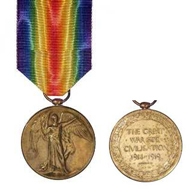
-
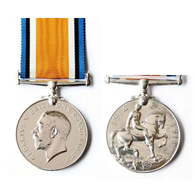
- January 1968
-
Palmwoods and District Roll of Honour, Palmwoods Memorial Hall, Margaret Street, Palmwoods
-
Photo: Group portrait of officers and NCOs of the 24th Machine Gun Company in March 1918. Sergeant Cedric Popkin is second from right in middle row.In the foreground are two Vickers machine guns on tripods. AWM No. E01716
Casualty List 417 of 16 August stated Cpl Cedric Bassett Popkin of Palmwoods was wounded. (Chronicle 23 Aug 1918 p2)
Soldier's History References:
Qld Regn B009200 p5350) Ancestry.com
William Bassett (known as Dan) Popkin m. Lillian Martha Gilbert, 11 October 1884 Queensland, (Regn B009200 p5350)
NSW BDM Regn 12917
NSW BDM Regn 13578
NSW BDM Regn 32243
NSW BDM Regn 9259
http://blogs.ancestry.com/au/2011/03/03/entrance-books-for-the-vernon-and-the-sobraon-1867-1911/
Qld BDM Regn B013100, p21048
NSW BDM Regn 4626
Roland G Popkin, 762984, a law student, enlisted in 1916 in 28th Battalion, Artists' Rifles. He died in France, aged 24, on 27 Sept 1918.
AWM E01716 Group portrait of officers and NCOs of 24th Machine Gun Company date 8 March 1918 in France. Sgt Popkin 2nd from right middle row.
Baron von Richthofen: The Red Baron http://www.awm.gov.au/exhibitions/1918/people/rbaron.asp
NOVA's "Who killed the Red Baron", http://www.pbs.org/wgbh/nova/redbaron/
AIF War Diary of 24th Aust. M.G.Coy for April 1918, AWM4 24/24/8
'Red Baron' Photos courtesy of John Nichols.
- Chrissy

